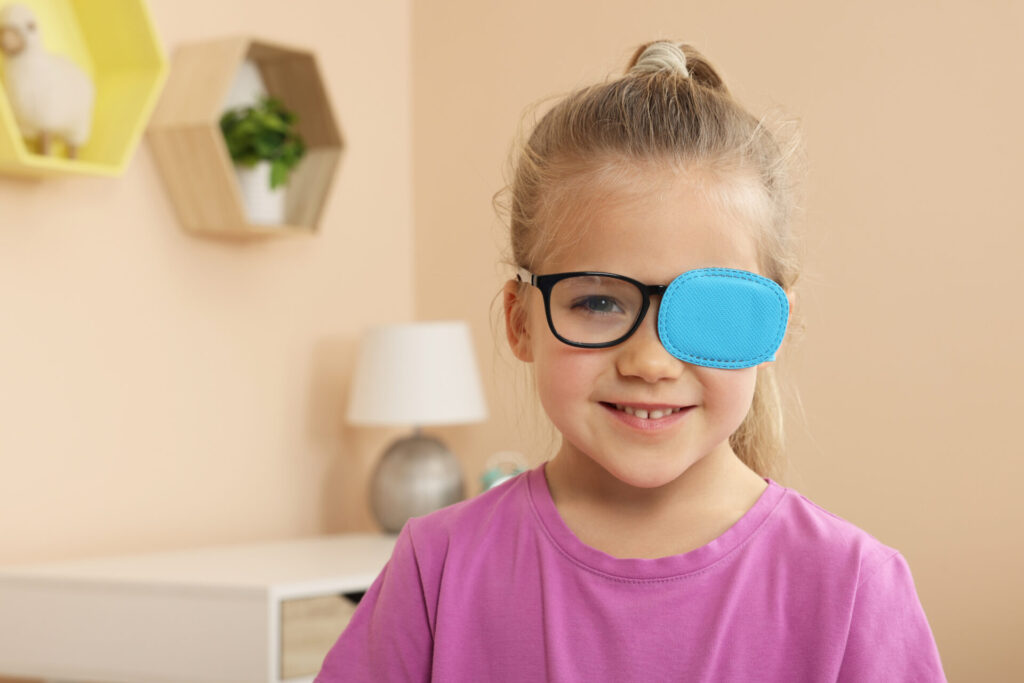What is Strabismus?
Strabismus is a complex condition where the brain has difficulty processing information from both eyes together. Improved visual skills can be taught to the strabismic eye, and as it builds better visual performance both eyes can be taught to work together, eliminating the eye turn. Treatment may include glasses or contact lenses with special lens designs, such as iseikonic lenses, to ensure the image quality is equal between the two eyes. Prism lenses may be used to improve eye alignment or to make it easier for the brain to use both eyes together. Patching may be used if amblyopia, or a lazy eye, is also present in order to quickly improve the visual acuity in the strabismic eye. In most cases once these levels of treatment are performed the cosmetic appearance of the eye turn is no longer a concern and more invasive treatments such as botox or surgery are not required.
Strabismus, often referred to as “cross-eye” or “eye turn,” is a condition where the eyes are not properly aligned and point in different directions. The term “cross-eye” is often used to describe strabismus when one eye turns inward, creating a visible crossing of the eyes. This condition affects not only your vision, but can also impact academic, sports and social performance.
In a person with strabismus, one eye may look straight ahead while the other eye turns inward, outward, upward, or downward. This misalignment can be constant or only occur occasionally, with the eyes taking turns deviating from their normal positions.
Strabismus isa condition that can vary widely in severity, with consequences ranging from minor cosmetic issues to more serious vision problems. Treatment recommendations and prognosis are dependent on the severity of the condition.
Strabismus is not limited to children, though it is most commonly diagnosed in childhood. Adults can also develop strabismus, often due to factors like traumatic brain injury, neurological conditions, or uncorrected childhood strabismus. The condition may manifest at any age, making it crucial to monitor eye health throughout their life.
Signs of Strabismus:
- Eyes that look in different directions
- One or both eyes crossing, turning inward, or turning outward
- Eyes do not move together
- Frequently closing one eye or squinting
- Head tilting to look at objects
- Depth perception issues including bumping into objects
- Headaches, nausea, and dizziness

Vision Therapy
Vision therapy is a specialized program designed to address various vision-related issues, including strabismus, in both children and adults. This therapy is conducted by our certified vision therapists and directly supervised by a Doctor of Optometry. It is a non-invasive and highly effective approach to help correct strabismus and improve overall eye health, coordination and visual function.
Treating Strabismus in Children
Children are often the primary recipients of vision therapy for strabismus, as early intervention is crucial to prevent potential long-term vision problems. The first step of treatment is a comprehensive evaluation to fully assess the child’s eye health, clarity of vision, and the degree of the eye misalignment. Once we have a complete picture of your child’s strabismus, we then can create a personalized treatment plan. There are many treatment options available and your child will most likely have a variety of therapeutic choices.
Treating Strabismus in Adults
Adults can also benefit from vision therapy for strabismus. As a child a strabismus patient may develop ways to compensate for their eye turn making them asymptomatic. As this patient gets older they may lose the efficiency of their visual system and the compensations may no longer be effective. This can result in eye strain, fatigue, discomfort, or even double vision. Vision therapy can be useful to improve efficiency and eliminate these associated symptoms. In an adult with new onset strabismus vision therapy can help teach a patient to use their eyes in a different want to eliminate double vision and eye strain. This should be performed after underlying neurological causes have been ruled out, or managed.
Eye Health Treatment Options
Patching and Eye Drops
Covering one eye for small or large portions of the day
Eyeglasses or Contact Lenses
Glasses designed to straighten the eyes
Convergence Exercises
Visual and spatial exercises that gradually increase in complexity
Prism lenses
Specialized lenses that shift images to align the eyes
Botox Injections
Specifically targeted injections to relax targeted eye muscles
Surgery
For complex cases, eye surgery may be required

Consulting on Treatments for Strabismus and Cross Eye
Childhood and adult strabismus is a serious eye health issue that should not be ignored. If you notice symptoms of strabismus in your child, it’s important to consult with an optometrist as soon as possible. Left untreated, strabismus can cause significant vision impairment, chronic poor eye health, and even vision loss. Choosing the right eye doctor for your child’s vision issues is vitally important. Count on our skilled and knowledgeable team at Vision by Design to treat your strabismus, cross eye, and eye turn issues with expertise, compassion, professionalism.
